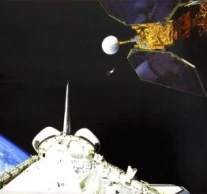satellite
China launches satellite Chinasat-9C
China successfully launched a new satellite, Chinasat-9C, into space on Friday night from the Xichang Satellite Launch Center located in Sichuan Province in the southwest of the country.
The satellite was lifted off at 8:37 p.m. (Beijing Time) aboard a Long March-3B carrier rocket and successfully reached its designated orbit.
Chinese researchers develop cocktail hydrogel for brain injury therapy
This mission marks the 582nd flight of the Long March rocket series.
A Long March-3B rocket carrying the Chinasat-9C satellite was seen blasting off from the Xichang Satellite Launch Center on June 20, 2025, continuing China’s steady progress in space technology and satellite deployment.
6 months ago
China successfully launches new satellite into space
China successfully launched a new satellite, Shijian-26, into space on Thursday using a Long March-4B carrier rocket.
The launch took place at 12:12 p.m. (Beijing Time) from the Jiuquan Satellite Launch Center in northwest China.
Cliffside wonders elevate tourism in east China
Shijian-26 is designed primarily to support national land surveys, environmental monitoring, and other related fields, offering information services that contribute to the country's economic development.
This launch marked the 579th mission of the Long March series of carrier rockets.
7 months ago
Bangladesh to welcome France’s approach to set up satellite factory: Momen
Foreign Minister Dr AK Abdul Momen on Thursday (August 31, 2023) said Bangladesh would welcome France’s proposal to set up a satellite factory in the country.
"They (France) actually proposed setting up a satellite factory back in 2021. We would welcome it," Momen told reporters at a briefing at the Ministry of Foreign Affairs.
Read: India is a mature govt, they can say something for regional interest: Momen
France also proposed a second satellite for Bangladesh. Earlier, France manufactured the first satellite for Bangladesh, named Bangabandhu-1.
The relevant issues are likely to be discussed during the upcoming visit of France President Emmanuel Macron which is likely to begin on September 11.
Foreign Minister Momen on Wednesday said Bangladesh and France would discuss ways to enhance trade and investment between the two countries apart from discussing issues like climate change and regulated migration if President of the French Republic Emmanuel Macron visits Bangladesh next month.
Bangladesh will welcome him as an initiative has been taken for his visit to Bangladesh after the G20 Leaders Summit in New Delhi, he said.
Read: Chandrayaan-3 a glowing testament to what India can achieve with passion: Indian Cabinet
“The President of France has been invited to visit Bangladesh and if he comes, Bangladesh will welcome him,” he told reporters at the Foreign Service Academy.
He, however, did not want to mention the date of his arrival in Dhaka. "We are yet to finalize it. We are working on this."
President Macron is likely to be here on September 11 to hold bilateral talks with Prime Minister Sheikh Hasina, a diplomatic source told UNB. He will leave Dhaka on September 12.
However, there is no official announcement regarding the visit that is seen as further efforts to deepen ties between the two countries on all key fronts.
“Women empowerment, enhancing trade and commerce and regulated migration – these are normal issues. Climate change is a big issue. The President of France has taken a leadership role,” Momen said, adding that Bangladesh will raise the loss and damage issue and its making functional of its relevant fund in a big way.
Read: Momen to hold talks with Russian FM Lavrov September 7
At the invitation of the President of the French Republic, Prime Minister Sheikh Hasina visited France in November, 2021.
Apart from holding bilateral talks with Prime Minister Sheikh Hasina, the French President will visit Bangabandhu Memorial Museum in city's Dhanmondi to pay homage to Father of the Nation Bangabandhu Sheikh Mujibur Rahman
The two leaders are scheduled to attend the G20 Summit in New Delhi on September 9-10.
France and Bangladesh welcomed the growth of their friendship, and highlighted their shared will to develop and deepen all aspects of their partnership through regular political consultations for strategic guidance.
Read: Cooperation framework to be developed to tackle organized crimes, address challenges
Both countries reiterated their determination to enhance cooperation in all areas, including politics and diplomacy, defence and security, trade and investment, sustainable development and climate change, and education and cultural exchange.
Both countries also recognized the importance of sustained and substantive cooperation in relevant regional and multilateral fora.
Bangladesh and France stated their will to further develop the defence and security component of their partnership.
To that end, both countries agreed to strengthen dialogue and continue their cooperation, in particular the area of training, which was launched during this visit.
Furthermore, they committed to stepping up cooperation in the area of defence equipment based on the needs expressed and each party’s ability to respond to them, including through capacity building and potential technology transfer. In this regard, both parties welcomed the signing of a Letter of intent on defence cooperation.
France and Bangladesh shared the same vision for a free, open, peaceful, secure and inclusive Indo-Pacific region, based on international law and with shared prosperity for all.
2 years ago
StarLink: What's special about Elon Musk's SpaceX satellite internet service?
In today’s interconnected world, access to reliable and high-speed internet has become an essential aspect of modern life. The internet serves as the backbone of communication, information sharing, education, business, and countless other activities that shape our daily routines. However, despite the significant advancements in internet technology over the past few decades, a considerable part of the global population remains underserved or even entirely disconnected from the digital world. This digital divide is particularly evident in rural and remote areas, where traditional internet infrastructure is often impractical or prohibitively expensive to deploy.
To address this pressing issue and fulfill the growing necessity for internet services worldwide, innovative solutions have emerged. One of the most ambitious and groundbreaking ventures is Starlink, a satellite internet constellation project spearheaded by SpaceX, the private space exploration company founded by Elon Musk.
What is StarLink?
Starlink is a project created by SpaceX, a private company led by Elon Musk. They're putting a bunch of satellites up in space to make the internet work better for everyone. These satellites form a "constellation" and help bring the internet to even the remotest places on earth. Officially launched in 2019, the primary goal of Starlink is to provide global internet coverage by deploying a large number of small satellites into low earth orbit (LEO).
Read more: How AI Can Improve Education
Everything we know about Elon Musk’s Starlink Satellites and Future Internet Plans
As of May 2023, Starlink’s operational network encompasses more than 4,000 mass-produced, compact satellites positioned in LEO. These satellites maintain communication with specific ground transceivers. The ambitious project aims to deploy a total of nearly 12,000 satellites, with potential future expansion of up to 42,000 satellites. Notably, SpaceX celebrated reaching a significant milestone by acquiring over 1 million subscribers in December 2022, and within just a few months, that number surged to 1.5 million subscribers as of May 2023.
The Starlink Constellation: Size and Ambition
The Starlink constellation consists of thousands of satellites orbiting at altitudes between 340 km (210 miles) and 1,200 km (750 miles) above earth’s surface. These satellites work in a cycle to create a network that beams high-speed internet signals down to earth, making it accessible to users with compatible receiving terminals, commonly referred to as user terminals or satellite dishes.
Starlink’s internet is different from regular internet because it doesn’t use towers and cables on the ground. Instead, it has satellites that fly much closer to the earth. This closeness makes the internet faster because data doesn’t have to travel as far. It’s like having a shorter distance for messages to go back and forth between you and the satellite. This is really helpful in places that are far away from cities or places where getting good internet is hard. So, Starlink can provide better internet performance, especially in those remote and underserved areas.
Read more: Top 10 Humanoid AI Robots in 2023 So Far
Beta Testing and Expansion
Starlink has conducted multiple phases of beta testing, known as the “Better Than Nothing Beta” program, where users in select regions were invited to test the service and provide feedback. During the beta phase, the system underwent improvements and optimizations based on user experiences.
As the beta testing progresses, SpaceX has gradually expanded the coverage area, reaching more users in different parts of the world. The company has been seeking regulatory approvals from various countries to operate its satellite internet service globally.
User Terminals (Satellite Dishes)
To access the Starlink internet service, users receive a phased-array satellite dish, commonly known as a user terminal or satellite dish. These user terminals are designed to automatically track and connect to passing satellites overhead, making it easy for users to set up and use the service.
2 years ago
North Korean leader’s sister vows 2nd attempt to launch spy satellite, slams UN meeting
The influential sister of North Korean leader Kim Jong Un vowed again Sunday to push for a second attempt to launch a spy satellite as she lambasted a U.N. Security Council meeting over the North's first, failed launch.
The North's attempt to put its first military spy satellite into orbit last Wednesday failed as its rocket crashed off the Korean Peninsula's western coast. An emergency meeting of the U.N. Security Council was still convened at the request of the U.S., Japan and other countries to discuss the launch because it had violated council resolutions banning the North from performing any launch using ballistic technology.
On Sunday, Kim's sister and senior ruling party official, Kim Yo Jong, called the U.N. council "a political appendage" of the United States, saying its recent meeting was convened following America's "gangster-like request."
She accused the U.N. council of being "discriminative and rude" because it only takes issue with the North's satellite launches while thousands of satellites launched by other countries are already operating in space. She said her country's attempt to acquire a spy satellite is a legitimate step to respond to military threats posed by the U.S. and its allies.
"(North Korea) will continue to take proactive measures to exercise all the lawful rights of a sovereign state, including the one to a military reconnaissance satellite launch," Kim Yo Jong said in a statement carried by state media.
In her earlier statement Friday, Kim Yo Jong said the North's spy satellite "will be correctly put on space orbit in the near future" but didn't say when its second launch attempt would take place.
South Korea's spy agency told lawmakers Wednesday it will likely take "more than several weeks" for North Korea to learn the cause of the failed launch but it may attempt a second launch soon if defects aren't serious.
Washington, Seoul and others criticized the North's satellite launch for raising international tensions and urged it to return to talks.
A military surveillance satellite is among a list of sophisticated weapons systems that Kim Jong Un has vowed to acquire amid protracted security tensions with the United States. Since the start of 2022, Kim has carried out more than 100 missile tests in what he called a warning over expanded military drills between the U.S. and South Korea.
Experts say Kim would want to use his modernized weapons arsenal to wrest concessions from Washington and its partners in future diplomacy.
North Korea was slapped with rounds of U.N. sanctions over its past nuclear and missile tests and satellite launches. But the U.N. Security Council failed to toughen those sanctions over North Korea's recent testing activities because China and Russia, both permanent members of the U.N. council, blocked the U.S. and others' attempts to do so. During the latest U.N. council session Friday, China and Russia again clashed with the U.S. over the North's failed launch.
After repeated failures, North Korea placed Earth-observation satellites into orbit in 2012 and 2016, but foreign experts say there is no evidence that either satellite transmitted imagery and other data.
Also Sunday, North Korea threatened not to notify the International Maritime Organization of future satellite launches in advance to protest the group's condemnation of North Korean missile tests.
The IMO's maritime safety committee on Wednesday adopted a rare resolution denouncing North Korea for conducting launches without proper notification that "seriously threatened the safety of seafarers and international shipping."
Kim Myong Chol, an international affairs analyst in North Korea, said in a statement carried by state media: "In the future, IMO should know and take measures by itself over the period of (North Korea's) satellite launch and the impact point of its carrier and be prepared to take full responsibility for all the consequences from it."
Ahead of its recent spy satellite launch, North Korea told the IMO and Japan that a launch would occur between May 31 and June 11.
2 years ago
Old NASA satellite falling from sky this weekend, low threat
A 38-year-old retired NASA satellite is about to fall from the sky.
NASA said Friday the chance of wreckage falling on anybody is “very low.” Most of the 5,400-pound (2,450-kilogram) satellite will burn up upon reentry, according to NASA. But some pieces are expected to survive.
The space agency put the odds of injury from falling debris at about 1-in-9,400.
The science satellite is expected to come down Sunday night, give or take 17 hours, according to the Defense Department.
Read more: NASA says spacecraft succeeded in changing asteroid’s orbit
The California-based Aerospace Corp., however is targeting Monday morning, give or take 13 hours, along a track passing over Africa, Asia the Middle East and the westernmost areas of North and South America.
.The Earth Radiation Budget Satellite, known as ERBS, was launched in 1984 aboard space shuttle Challenger. Although its expected working lifetime was two years, the satellite kept making ozone and other atmospheric measurements until its retirement in 2005. The satellite studied how Earth absorbed and radiated energy from the sun.
The satellite got a special sendoff from Challenger. America's first woman in space, Sally Ride, released the satellite into orbit using the shuttle's robot arm. That same mission also featured the first spacewalk by a U.S. woman: Kathryn Sullivan. It was the first time two female astronauts flew in space together.
Read more: NASA Orion capsule safely blazes back from moon, aces test
It was the second and final spaceflight for Ride, who died in 2012.
2 years ago
North Korea says rocket launch was test of 1st spy satellite
North Korea said Monday it fired a test satellite in an important final-stage test for the development of its first spy satellite, a key military capability coveted by its leader Kim Jong Un along with other high-tech weapons systems.
The North’s official Korean Central News Agency also released black-and-white photos showing a space view of the South Korean capital and Incheon, a city just west of Seoul, in an apparent attempt to show the North is pushing to monitor its rival with its advancing technologies.
The rocket carrying the test satellite was launched Sunday to assess the satellite's photography and data transmission systems, KCNA said.
Read more: North Korea calls UN's Guterres 'puppet of US' after launch
The country’s National Aerospace Development Administration called the test results “an important success which has gone through the final gateway process of the launch of reconnaissance satellite." It said it would complete the preparations for its first military reconnaissance satellite by April next year, according to KCNA.
“From the images released, the resolution does not appear to be so impressive for military reconnaissance,” Soo Kim, a security analyst at the California-based RAND Corporation, said. “I’d note, however, that this is probably an ongoing development, so we may see more improvements to North Korea’s military reconnaissance capabilities over time.”
South Korea, Japan and U.S. authorities had said Sunday they had detected a pair of ballistic missile launches by North Korea from its northwestern Tongchang-ri area, where the North's satellite launch pad is located. They said the two missiles flew about 500 kilometers (310 miles) at a maximum altitude of 550 kilometers (340 miles) before landing in the waters between the Korean Peninsula and Japan. This could mean North Korea might have fired a missile or two to send the test-piece satellite into space.
Read more: Missile tests practiced to attack South, US: North Korea
A spy satellite was on a wish list of sophisticated military assets Kim announced during a ruling party meeting early last year, together with multi-warhead missiles, solid-fueled long-range missiles, underwater-launched nuclear missiles and nuclear-powered submarines. Kim has called for such high-tech weapons systems and an expanded nuclear arsenal to pressure the United States to abandon its hostile polices on North Korea, an apparent reference to U.S.-led sanctions and the U.S.-South Korean military drills that North Korea views as an invasion rehearsal.
North Korea has since taken steps to develop such weapons systems. In February and March, North Korea said it conducted tests to check a camera and data transmission systems to be used on a spy satellite. In November, it test-launched its developmental, longest-range Hwasong-17 intercontinental ballistic missile, a weapon believed to be designed to carry multiple warheads. Last week, North Korea said it performed a “high-thrust solid-fuel motor” to be used for a new strategic weapon, an apparent reference to a solid-fueled ICBM.
Ankit Panda, an expert with the Carnegie Endowment for International Peace, said that North Korea will likely make a proper orbital launch for a reconnaissance satellite next April — probably around April 15, the birthday of Kim’s late grandfather and state founder Kim Il Sung. The day is one of the most important state anniversaries in North Korea.
Earlier this year, North Korea test-launched a record number of missiles, many of them nuclear-capable missiles with varying ranges to reach the U.S. mainland and its allies South Korea and Japan. It also legislated a law authorizing the preemptive use of nuclear weapons on a broad range of scenarios, causing security jitters in South Korea and elsewhere.
North Korea has avoided fresh U.N. sanctions for those moves, however, because U.N. Security Council permanent members Russia and China won't support U.S. attempts to impose them.
“Having codified his country’s nuclear law earlier this year, tested missiles of varying capabilities, and made it very clear he has no interest in diplomacy with the U.S. and South Korea, Kim has essentially paved the way for nuclearization,” Soo Kim, the analyst, said. “He’s lent the appearance that the only possible way out of this quagmire is for the international community to fold the conditions set forth by the regime."
She said a handful of other high-priority geopolitical concerns involving China and Russia “has allowed Kim to buy time and the grace of the international community to push forward with his plan.”
3 years ago
iPhone 14 launch: Game-changing emergency services via satellite
When regular service is unavailable, you will be able to connect to emergency services through satellite with the latest iPhone 14 model.
To connect to satellite, and to maintain that connection, iPhone14 will provide directions on where to position it.
More from iPhone 14 launch event
With a redesigned main camera that captures 49% more light and new Photonic Engine technology, Apple’s iPhone 14 and iPhone 14 Plus address a major weakness in smartphone cameras: low-light shooting.
Apple said that the Photonic Engine technology works on all the new phones' cameras, including its new selfie camera and ultrawide rear camera. The main wide-angle camera has a larger f1.5 aperture so that its lens can let in more light, CNET reports.
Read: Android 14 to feature satellite connectivity support
At its fall product launch event on Wednesday, Apple introduced the new camera technology, marking a significant occasion on the yearly technology calendar. The iPhone is a major company in and of itself, but it also serves as the cornerstone of a massive digital ecosystem that is deeply ingrained in the lives of millions of people. This ecosystem includes services like iCloud and Apple Arcade as well as peripherals like AirPods and Apple Watches.
One of the most obvious differences from smartphone models from one year to the next is the camera, especially since that designers have adopted bigger, protruding lenses as a defining feature. Customers may not notice a speedier processor, but they may notice the introduction of additional camera modules, such as the telephoto and ultrawide options now ubiquitous on high-end phones.
Highlights of iPhone 14
● New 12 MP main camera with larger sensor and pixels
● Faster f1.5 aperture, Sensor-shift OIS
● 49% improvement in low light capture
● Autofocus front camera
● New action mode for video
● US models no longer have SIM tray
● Crash detection
● Emergency SOS via Satellite (free for two years, launches in November in US and Canada).
Read International Roaming: How to use a Bangladeshi SIM card abroad
3 years ago
Android 14 to feature satellite connectivity support
Wouldn’t it be great if you could call without a network using your Android phone? It might sound like a sci-fi movie, but the truth is we are going to get this feature on the Android 14 operating system. Motorola invented the first satellite phone in 1989. However, satellite phones were not available to the general public. Now it seems anyone can use it in the coming years. Let’s get to know more about Android 14 and its satellite connectivity.
Android 14 to feature satellite connectivity support
Google’s new operating system, Android 13, was unveiled at the end of July. Google released information about the beta version of Android 14 before Android 13 became a month old. As a surprise, this new version of Android will have satellite connectivity, claimed Google Ecosystem Senior Vice President Hiroshi Lockheimer.
According to his tweet, the next version of Android will have satellite connectivity. Google will help partners with this. It is expected that the beta version will be launched in 2023. He also said that the handsets would be linked directly to satellites to further improve the smartphone user experience around the world, which will be quite different from the current cellular connectivity.
Read Metaverse Real Estate Investment: Buying Land, Apartment, Property in Virtual World
However, Hiroshi Lockheimer did not give any details about this. But, it is expected that the old Android phones will also be able to get this feature by updating the operating system.
Other than this feature of the ‘next-generation Android 14 operating system, no other possible features have been revealed yet.
On the other hand, Elon Musk’s SpaceX partnered with T-Mobile to develop satellite connectivity.
What are the features to expect from satellite connectivity?
Many people think that satellite connectivity means very high-speed internet. But it is not the actual feature. One of the advantages of satellite phones is that even in remote, uninhabited areas where there is no cellular network, the user can communicate through SMS and calling. In the initial phase, only calls, SMS, and MMS will be available on satellite connectivity.
Read How to Get a Job in Google from Bangladesh?
According to Lockheimer, satellite connectivity will provide many times better service than what can be experienced with standard LTE and 5G connections. This feature will start a new chapter in the communication system.
SpaceX & T-Mobile to introduce satellite features for phones in the USA
While we’re on the subject, the buzz in the tech world is that SpaceX and T-Mobile are teaming up to bring satellite connectivity to phones in the US. The telecom operator has already confirmed that it plans to use thousands of Starlink satellites to provide wireless connectivity to mobile users in remote areas of the country. Under this service, customers will be able to use the beta version of satellite internet on T-Mobile by June 2023. In addition to that, voice and data services are also expected to be offered later.
Elon Musk also said on Twitter that the Starlink V2 service will be launched in 2023 with a plan to “eliminate the global dead zone.” He even invited other companies to work with Starlink.
Read Google Alphabet’s Project Taara: Light beam broadband internet creates new hope in Africa
Will iPhone 14 have satellite features?
On the other hand, the tech giant Apple is preparing to announce the iPhone 14 series on 7th September. There has been speculation that the satellite connectivity feature may be added as a ‘wild card’ feature in the lineup.
As Bloomberg pointed out in a 2021 report, the tech giant has already completed hardware testing for satellite communication in the iPhone 14 series. This feature will allow users to connect to mobile networks to send messages in emergency situations in remote areas. Users will even be able to use the iPhone to report their situation in areas without cellular coverage.
However, Apple device analyst Ming-Chi Kuo is not yet sure if the feature will be made available in the iPhone 14 lineup at all. Because of this, Apple will have to tie up with a satellite operator, and no such deal has been reported yet. But if the feature is included, the satellite connectivity of the iPhone 14 series will only provide essential text message and voice services.
Read Shammi Quddus: A Talented Bangladeshi Woman in Google, Global Fintech Industry
Will satellite connectivity be available worldwide?
The answer is a bit tricky. Companies such as Google and Apple will need to take permission/license from the particular countries they are intended to offer services, as satellite connectivity may raise security concerns. To recall, SpaceX previously returned pre-booked money to the Indian customers as they did not have a license from the Indian Department of Telecommunications.
As the world is becoming more technology-driven, the countries may lessen the regulations regarding satellite usage. Hence, satellite connectivity might be available worldwide in the coming years.
Final words
The use of Satellite phone technology in Android 14 can improve the future of communication because it doesn’t need the conventional mobile network. Furthermore, it is more reliable, and easier to use than traditional methods. With the right technology in place, people can easily stay connected no matter where they are in the world. However, in terms of pricing, satellite connectivity might be expensive initially.
Read Top 10 mobile phones coming to Bangladesh in September 2022
3 years ago
China launches new satellite for Earth observation
China launched a new Earth observation satellite from the Jiuquan Satellite Launch Center in northwest China on Thursday.
The satellite, Gaofen-3 03, was launched by a Long March-4C rocket at 7:47 a.m. (Beijing Time) and has entered the planned orbit successfully.
The satellite will be networked with the orbiting Gaofen-3 and Gaofen-3 02 satellites to form a land-sea radar satellite constellation and capture reliable, stable synthetic aperture radar (SAR) images.
Also Read: Weather satellite rockets to orbit to monitor US West
These images will boast a 1-meter resolution together with a one-day revisit period, thereby improving the monitoring capabilities of China's land-sea radar satellites.
It will serve the fields of marine disaster prevention and mitigation, dynamic marine environment monitoring, marine research, environmental protection, water conservancy, agriculture and meteorology, while helping to safeguard maritime rights and interests.
The launch marks the 414th mission for the Long March series carrier rockets.
Also Read: North Korea says it tested cameras for spy satellite
3 years ago

















